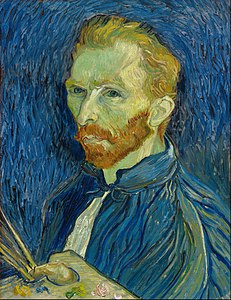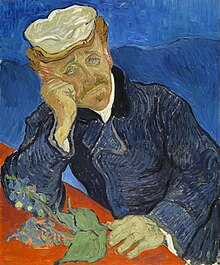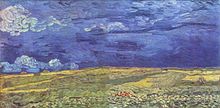Vincent (opera)
| Opera dates | |
|---|---|
| Title: | Vincent |

Vincent van Gogh, self-portrait (1889) |
|
| Shape: | Opera in two acts |
| Original language: | English |
| Music: | Bernard Rands |
| Libretto : | JD McClatchy |
| Literary source: | Van Gogh's letters |
| Premiere: | April 8, 2011 |
| Place of premiere: | Indiana University Opera Theater, Bloomington |
| Playing time: | about 2 hours |
| Place and time of the action: | France, 1870-1890 |
| people | |
|
|
Vincent is an opera in two acts by Bernard Rands (music) with a libretto by JD McClatchy . It is about the life of the painter Vincent van Gogh . It premiered on April 8, 2011 at the Indiana University Opera Theater in Bloomington .
action
first act
Scene 1: Arles, 1889
A man sits in a chair on the empty stage. It is Vincent von Gogh who writes a letter to his brother Theo in Paris, in which he recapitulates his life - starting with the words: "When I feel the need for religion, I go outside and paint the stars".
Scene 1a: The Van Gogh family home in the Netherlands, 1870
Vincent's father Theodorus assumes that Vincent will maintain the family tradition and, like himself and his own father, pursue the career of a Protestant pastor. Theo shows him some of his brother's drawings and persuades him to let Vincent move to his uncle Cent, an art dealer, in Paris to continue his art studies.
Scene 2: Paris, 1875
In the gallery of his uncle's art dealer, visitors look at the pictures on display. Cent took in the 22-year-old religiously inclined Vincent and tried to familiarize him with his business. Vincent is supposed to have sales pitches, but finds that none of the customers are really interested in art. He insults her: "You are talking about furniture and I am talking about God!" A lady complains to her uncle, who confronts Vincent about it. They both find that a career as an art dealer is not right for Vincent. Cent recognizes Vincent's talent, but says: “God doesn't need you! Nobody needs you, Vincent! "
Orchestral interlude
Scene 3: Belgium, 1878
Several miners were buried in a mining accident. Their families and other miners have gathered on site with concern while the rescue work is in progress. Vincent tries to morally support those present. He starts a religious song with them and begins to give a sermon. In doing so, however, he stutters and collapses. Those present lose interest and turn back to the rescue measures.
Scene 4: Belgium, a mission church in the Borinage, 1878
In front of the church, Theo calls for his brother. He enters and sits on the front bench, where he looks through some of Vincent's drawings. Vincent, who had slept on one of the back benches, joins them. Theo praises him for the great progress that is visible in the drawings. He asks him why he is wasting his time in church when he has so much talent. Vincent, however, has no interest in an artistic career, but wants to spread the word of God. He thinks art is just a way to study God's creation. Theo tells him that her parents have been invited by the Evangelical Congregation to hear him preach. Theodorus and Anna von Gogh appear and greet their son. You have heard of his failure with the miners, however, and Theodorus no longer believes that Vincent could be a good pastor. Unlike his son, he himself studied languages, theology and history. Nevertheless, Vincent wants to follow in his footsteps. He goes to the lectern and begins his sermon. After a short time, he is overwhelmed by feelings, breaks down in tears and has to break off the speech. His father repeats his uncle's words: “God doesn't need you! Nobody needs you, Vincent! "
Scene 5: The Hague, 1882
Vincent has now turned to painting. He lives in a poor room that doubles as a studio. His paintings are everywhere. He is working intensively on the sketches of a chair when there is a knock on the door and his brother Theo enters. At first displeased about the disturbance, he is pleased to see him again. Theo tells him about his engagement to Johanna. He has also brought a package with painting supplies, which Vincent is very welcome. The door opens again and Vincent's pregnant friend “Sien”, the prostitute Clasina Hoornik, enters with her child. Even though none of the children are his, Vincent insists on wanting to marry Sien. Theo leaves the room horrified and angry. Vincent starts drawing Sien, but she gets bored quickly. She has no love for Vincent. Theo comes back and apologizes for his behavior. He found out about Sien's work in the café. If Vincent were to actually marry her, that would make his own marriage to Johanna impossible. Sien explains that she doesn't want to become a point of contention between the two brothers. One after the other, Theo and Sien leave the room. Sien concludes, “I don't need you. Nobody needs you, Vincent. ”Vincent remains alone and looks at some of the pictures of Sien.
Scene 6: Nines, 1885
In the empty room, Vincent is sitting passionately at his painting The Potato Eaters . He is obsessed with the idea of following God's plan and painting with God's colors.
Orchestral interlude
Scene 7: Paris, 1887
In the Café Le Tambourin on Montmartre , the boss Agostina Segatori serves the guests. It is a popular meeting place for artists. The walls are full of paintings. Agostina is Vincent's lover. The painters, including Paul Gauguin and Henri de Toulouse-Lautrec , are seated at tables on one side of the room. Vincent chats lively with his brother while the guests sing happily (“Je l'aime quand est au loin”). Lautrec introduces those present to Gauguin. He represents the future of painting and has already worked with Cézanne . The guests only mock him. Lautrec asks Agostina to play a song. While she sings ("Life is here, and then it's gone"), she first turns to Vincent and kisses him. But then she pats Theo's hair and finally flirts with Gauguin. Everyone gets drunk. Gauguin says he threw his wife and children out of the house. Agostina takes care of Vincent, then Gauguin again. The two painters find that they have some things in common. They decide to go south together to Arles to paint there.
Orchestral interlude
Second act
When the curtain is raised, the scene shows a glowing wheat field. The sun rises in the background. Vincent crosses the field with his easel and begins to paint. The sun gradually turns into one of his sunflowers.
Scene 1: Arles, 1888
Vincent has been living in the “Yellow House” in Arles for some time. Everyone has their own bedroom upstairs. Downstairs there is a common room with a cooking area. Vincent is working on the last lines of one of his sunflower pictures above. The walls of his room are full of pictures. In Gauguin's room, on the other hand, there are only pictures of sunflowers, to which Vincent now hangs the new one. Gauguin enters the house with his suitcase and painting tools and has Vincent show him his room. Vincent tells him how good the country life is for him. The artist life in Paris, however, ruined him. Soon other artists will join them and together they will develop the art of the future. But first he leads Gauguin to the well-frequented village café.
Scene 2: Arles, 1888, two months later
The two painters spent the evening with a prostitute. Gauguin is packing his suitcase to leave. He tells him that he came to paint and not to be taught. It turns out that they have very different ideas about art. Gauguin explains that he wants to give his pictures a symbolic depth. Vincent, on the other hand, only values intensity and ignores the shading: “That is not painting, Vincent. It's just color. ”Neither understands the other's goals. Even when Vincent pulls out a picture of the street to explain, he cannot convince Gauguin. Gauguin and the prostitute leave the house. In desperation, Vincent grabs a knife and cuts off his ear.
Scene 3: Saint-Rémy, 1889 - courtyard of the Saint-Paul-de-Mausole mental hospital
In the courtyard of the mental hospital in Saint-Rémy-de-Provence there are patients with various mental illnesses. Theo comes in and meets Vincent's doctor, Dr. Peyron, who tells him that Vincent is much better. However, his epilepsy is unpredictable and can cause terrible outbreaks. However, he started painting again and was able to go to the fields under supervision. The monastery bells ring for the Angelus prayer . Shortly afterwards Vincent also appears, who greets his brother with delight. He admits that his mind is not working properly. Theo tells him that he and Johanna are expecting a child and that if it is a boy they will call it Vincent. After Theo leaves, Vincent goes back to painting. He speaks to the trees in the courtyard, calls out "I am the painting" and crushes the tubes of paint in his mouth. A woman calls for the doctor.
Scene 4: Auvers, 1890 - the house of Dr. Gachet

Vincent has moved into the house of doctor Paul Gachet , where he paints a portrait that is now almost complete. Gachet's daughter Marguerite brings her father tea and asks how long Vincent wants to stay. She thinks he should be in a hospital. Dr. However, Gachet believes that he needs a home, company, and quiet more to paint. Vincent, who overheard part of the conversation, suggests leaving the house. Marguerite brings him a cup of tea, too, for which Vincent thanks him kindly and points out his feelings for her. Marguerite firmly rejects him. He talks about the history of his pictures, gets excited and knocks over the cup. When Marguerite rushes over to clean up, Vincent hastily packs his things. He repeats several times: "I shouldn't be here."
Orchestral interlude
Scene 5: Auvers sur Oise, France, 1890 - a field
Vincent paints the wheat field again from the beginning of the second act. This time there is no sun, only the blue sky. Still, he paints black streaks of cloud over the upper part of the picture. He knows that another attack could come at any moment. As he continues to paint, he remembers his brother and his acquaintances, who all have families - even if Gauguin disowned his. He decides not to be a burden to anyone anymore, takes out a pistol and shoots himself in the chest.
Scene 6: Auvers sur Oise, two days later - a room
As at the beginning of the first act, a man is sitting in a chair. This time it's not Vincent, but his brother Theo. Dr. Gachet and his daughter Marguerite come in, make a compassionate gesture, and then leave the scene. He now recognizes the bed in which the dying Vincent lies. He begs Theo not to leave him. Theo sits down next to him. Vincent speaks of his son, the new Vincent, who is not sick. Then he explains to him the meaning of his sunflowers: This is how he painted gratitude. He dies at his brother's side.
layout
The opera consists of a series of pictures that depict important stages in Van Gogh's life. The first act deals with his decision to pursue a career as a painter, the second with his progressive spiritual disruption and his death. A recurring theme is Vincent's always disappointed desire to be needed. The passionate portrayal of each person in his pictures is in stark contrast to his actual relationships with them. This failure manifests itself in the chorus-like repetition of the sentence “Nobody needs you, Vincent.” The only person who has stood by his side throughout his life is his brother Theo.
Instrumentation
The orchestral line-up for the opera includes the following instruments:
- Woodwinds : three flutes (3rd also alto flute and piccolo ), two oboes , three clarinets (3rd also bass clarinet ), two bassoons
- Brass : four horns , three trumpets , two tenor trombones , bass trombone , tuba
- harp
- Celesta
- Accordion (in scene 7 of the first act)
- piano
- Timpani , percussion (two players)
- Strings
music
In his composition Rands dispenses with the usual operatic forms of recitative and aria. He uses choirs or ensembles when it comes to setting Vincent apart from his surroundings. This himself is not musically included in the ensembles.
The musical language is predominantly post-tonal . Rands occasionally resorts to tonal elements to create a strong dramatic contrast. For example, there are echoes of Protestant chant in the utterances of Vincent's father. The song Agostinas is reminiscent of chansons from a Parisian cabaret. The Angelus prayer in the mental hospital is sung by the inmates in the manner of a Gregorian chant .
In the vocal parts, Rands often goes beyond pure singing. If necessary, he uses elements such as stuttering, coughing, stammering, whispering or spoken text, which are precisely noted in the score. In harmony he occasionally uses symbolic methods. Vincent's references to God, for example, are often accompanied by a spacious chord that includes all twelve notes of the chromatic scale.
Work history
The opera was commissioned by the Board of Trustees of Indiana University on the occasion of the 100th existence of the local music faculty, the Jacobs School of Music. The libretto comes from the American writer JD McClatchy , who referred to letters from Vincent van Gogh.
Arthur Fagen conducted the premiere on April 8, 2011 at the Indiana University Opera Theater in Bloomington . The production was by Vincent Liotta, the set by Barry Steele, the costumes by Linda Pisano and the choreography by Michael Vernon. There were two casts for the solo roles. Each of the two combinations took part in two of the four performances. The singers were David Adam Moore / Christopher Burchett (Vincent van Gogh), Jacob Williams / Will Perkins (Theo van Gogh), Luke Williams / Jason Eck (Theodorus van Gogh), Elizabeth Toy / Kelly Kruse (Sien), Peter Thoresen / Steven Linville (Henri de Toulouse-Lautrec), Krista Costin / Laura Boone (Agostina Segatori), Hirotaka Kato / Adam Walton (Paul Gauguin), Corey Bonar / Andrew Morstein (Dr. Peyron), James Arnold / Christopher Grundy (Dr. Paul Gachet) and Paloma Friedhoff / Jami Leonard (Marguerite Gachet). Video recordings of the performances of both casts were made available on the Internet.
The premiere received good reviews. However, it was noted that the visual elements (projections and elements of the stage set derived from Van Gogh's works) were more interesting and entertaining than the music. The four orchestral interludes with their "irregular rhythms and time measures and spacious chromatic chords" and the processing of Protestant chorales or French coffee house songs were best received.
In January 2015 the opera was presented at Opera America . Julian Wachner led the Novus Orchestra.
Recordings
- 9./15. April 2011 - Arthur Fagen (Conductor), Vincent Liotta (Staging), Barry Steele (Stage), Linda Pisano (Costumes), Michael Vernon (Choreography), Indiana University Philharmonic Orchestra and Opera Chorus.
Christopher Burchett (Vincent van Gogh), Will Perkins (Theo van Gogh), Jason Eck (Theodorus van Gogh), Kelly Kruse (Sien), Steven Linville (Henri de Toulouse-Lautrec), Laura Conyers (Agostina Segatori), Adam Walton ( Paul Gauguin), Andrew Morstein (Dr. Peyron), Christopher Grundy (Dr. Paul Gachet) and Jami Leonard (Marguerite Gachet).
Live from the Indiana University Opera Theater in Bloomington ; second cast in the world premiere production.
Naxos 8.669037-38 (2 CD).
Web links
- Program of the premiere (PDF, English)
- Supplement to the Naxos CD (PDF, English) from Chandos Records
- Libretto of the opera (PDF, English) from Naxos
- Carmen-Helena Tellez: The Premiere of Bernard Rands's VINCENT: Operatic Meditations on the Life of An Artist. Review of the world premiere atsequence21 (English)
- Charles H. Parsons: VINCENT review in American Record Guide on the Indiana University website
- Page from the score manuscript (PDF)
- Excerpt from the opera with David Adam Moore as Vincent van Gogh on YouTube
Remarks
- ↑ "irregular rhythms and meters and widely spaced chromatic chords" (von Rhein).
Individual evidence
- ↑ a b c Vincent. Work information from Schott Music , accessed on April 16, 2017.
- ^ A b c d Daniel Bishop: Program Notes on Vincent. In: Program of the 2011 premiere.
- ↑ Work information on bernardrands.com, accessed on April 15, 2017.
- ^ Program booklet for the world premiere in 2011.
- ^ Lynnette Porter: Van Gogh in Popular Culture. McFarland, Jefferson 2015, ISBN 978-0-7864-9442-2 , pp. 168 f. ( limited preview in Google Book search).
- ↑ Older Performances on bernardrands.com, accessed April 16, 2017.
- ↑ Vincent. CD information from Naxos , accessed April 16, 2017.





